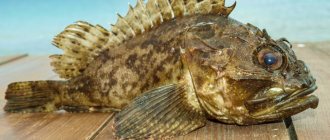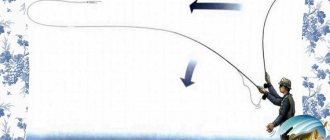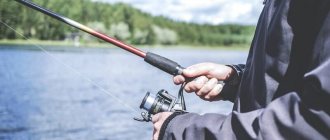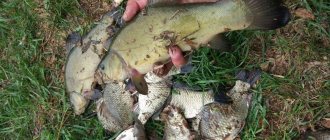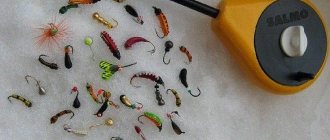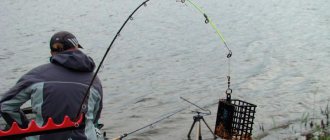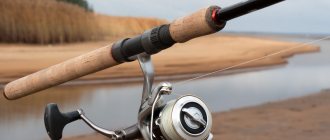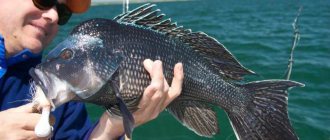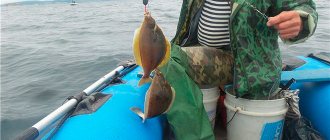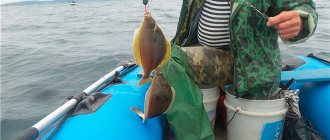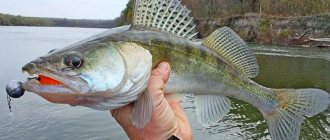Twitching - (from English - “twitch”), which means twitching. Actually, this is the main defining feature of such fishing, although, conditionally, any uneven wiring in principle can be classified as twitching.
Catching predatory fish is done by active animation of the bait when retrieving. And although many spinning baits can, to one degree or another, be used for fishing with aggressive jerks, first of all, this method uses a variety of wobblers.
First of all, this is, of course, a minnow. Jerking, which is similar in concept, uses specific, heavy baits, so it is included in a separate section of spinning fishing methods and can be recommended to fairly experienced anglers. In addition, high-quality jerk baits are not exactly affordable baits.
If, with uniform movements, wobblers make yaw movements along a trajectory, the amplitude of which depends on the structure of the bait, the presence of a blade, its size and shape, then in twitching sharp, short jerks with a rigid form have a different effect on the work of the wobbler. A short, clear jerk gives the movement of the bait an aggressive game, which provokes the predator to attack.
This technique is primarily used when fishing for pike. The active play of the bait often provokes even a well-fed predator to attack. Twitching also brings good results when hunting asp, ide, chub, as well as perch and pike perch. Twitching for beginning spinning anglers can be one of the most effective ways of fishing, after which you can begin to master more complex types of fishing.
Choosing a spinning rod for twitching
For successful fishing, the angler must “assemble” the appropriate kit. The choice of spinning rod is of primary importance. In twitching, rigid forms are used, which do not “fail” during animation and allow you to transmit a clear impulse even to the most stubborn and large models of wobblers.
Otherwise, the soft, sensitive tips bend under load and instead of a sharp jerk, a soft pull is obtained, which does not allow the wobbler to “start up”. Heavy casting rods are well suited for twitching.
Length
The length of the spinning rod is selected based on the fishing conditions. From a boat you can use slightly shorter forms than when fishing from the shore. In any case, the length is chosen so that the angler can make a clear jerk in any chosen amplitude.
Excessively short spinning rods allow you to do this, however, they are not entirely convenient when casting. But very long blanks do not allow the bait to be carried out in short jerks and are designed for a fairly high amplitude. Depending on the physical characteristics of the fisherman, it is better to choose a spinning rod with a length of 1.8 to 2.5 meters.
Test
The test primarily depends on the weight of the baits used and their “persistence”. Here you need to find a middle ground. On the one hand, medium-sized wobblers are well “twitched” by overweight forms. But, firstly, it is inconvenient to cast light baits with overrated rods.
Secondly, the form is too rigid, with a clearly overestimated test, and does not allow you to fully understand the behavior of the wobbler in water. However, even with forms with the same test range for the baits used, it can be difficult to achieve normal animation, especially if wobblers with a large depth, with a wide blade, and even in the current are used.
To summarize, we can say that in the absence of a specialized rod for twitching, you can take a blank with a slightly overestimated test, for example, when using a deep-sea wobbler weighing 15g, the rod should have a test of 10-30 or 15-40g.
Build
As already mentioned, twitching involves constant, confident contact with the bait. Therefore, at a minimum, fast (fast) spinning rods are used, and even better - extra fast (very fast). They allow you to animate all types of wobblers, while soft blanks are suitable for fishing with medium-sized crankbaits or shads.
Many manufacturers have rods in their product lines that are specially designed for twitching. These are “dry”, hard blanks with slightly overweight tops.
Smooth stretches during the fishing process can be done with a hard blank, but a short, accentuated jerk with a soft blank cannot be done.
Recommended spinning rods for twitching
There is a large selection of twitching rod models on the market; I recommend that beginners choose a stick from this list. Or consider purchasing spinning rods with a similar test and action.
- Nautilus Black Getter BGS862MH 2.59m 12-35g, Fast action
- Favorite Delta 2.7m, 5-28g, Fast action
- Nordic Stage Cheater 772MH 2,31m 12-35g, Fast action
- Black Hole Hurricane MS-702MH 2,13m 7-21g,
- Norstream Rebel 732MH 2.21m 10-28g, Regular tuning
- Aiko Ranger 225M 2.25m 6-32g, Extra Fast action
- Maximus Striker-X MSSX24MH 2.4m 15-40g, Fast action
Twitching line
In twitch fishing, the success of fishing depends on how well the angler can give the minnow wobbler a play. Based on this, inextensible braided fishing line is used much more often.
The braid allows you to give the wobbler a play in a very wide range of options - from light trembling of the bait in one place to relatively wide jerks. It's pointless to argue about the advantages of monofilament over braid, but there are real situations in which monofilament is preferable. For example, this is fishing for passive perch. As we know, a passive perch, like any perch by and large, sees a braided line perfectly well, and only when it is tuned to an active bite, in an active state, it can be caught perfectly with a simple braided line. But during a bad bite, when the perch is in a passive state, it is afraid of the braided line, and the number of bites quickly decreases. At such times, it is preferable to use monofilament.
Monofilament is much less noticeable in water. When biting perch passively, the bait must be applied in very small jerks with long pauses. During a pause, the perch may come up, examine the bait, and of course, if there is braided line there, he may not take the bait. While with monofilament he will take it away. The same applies to pike. There are situations when pike completely refuse to be caught on a braided line. So, despite the fact that many are sure that twitching is only possible with braided line, in reality there are situations when monofilament turns out to be preferable. If we talk about monofilament, then it is best to focus on high-quality monofilament. I would like to draw attention to fluorocarbon fishing lines, which are virtually invisible in water. In addition to the fact that they are hardly noticeable in the water, they have less elongation than a simple fishing line.
If you take a fluorocarbon line, its elongation will be somewhere between a simple mono line and a braided line. In other words, it stretches more than a braided line, but, however, significantly enough to fish with twitching. Thus, with fluorocarbon fishing line you can twitch perfectly, especially when fishing for perch. In addition, on some solid spinning rods with a rapier-shaped action, certain types of wobblers usually show a very aggressive game, and the fish are caught worse on them. In such situations, it is worth putting a simple monofilament line on the same spinning rod, and the wobbler comes to life and displays all its properties, in other words, it begins to twitch perfectly.
Moreover, the twitch is not frisky, but softer, and this works for passive fish. Based on this, you should not specifically abandon monofilament. At the moment we have come to a very interesting place, there is a wash and a snag under the shore. Last season I caught a couple of good trout in this place. The place is quite fascinating. The coast is open, it’s sunny now, so you need to approach it very quietly and carefully. If we rise to our full height on the shore and are visible far beyond the edge of the shore, the fish may notice us, due to the fact that it stands with its head against the current, and we will make a retrieve against the current. Based on this, we will now try to approach with precautions and see whether there is fish there at the moment or not.
Rice. 59-3
Rice. 59-4 We make the first cast on the river (Fig. 59-3, 59-4). If you plan to fish with a braided line, then for perch twitching wobblers, for example, it is best to choose the narrowest braid, with a real diameter of 0.1-0.13 mm (we are talking about the diameter of the fishing line comparable to the diameter of the same monofilament, in other words visually the braid and monofilament should be uniform). Typically, line diameters are now shown incorrectly; you have the opportunity to purchase braided line with a diameter of 0.1 mm, and it will turn out to be comparable to mono line with a diameter of 0.2 mm. If we talk about fishing line for pike, then it is optimal to use braid with a real tensile strength of 4-8 kg.
When fishing in a clean place, it is better to use a narrower braided line so that you can cast it further. If you are fishing in overgrown places, where casting range is not primary, the accuracy of casting and the restraining resource of the braid are much more important, based on this, it is better to take an 8-kilogram one for breaking. !As for monofilaments, for perch, for example, a monofilament with a maximum diameter of 0.14-0.22 mm is used. Let us remind you that much more often monofilament with a diameter of more than 0.2 mm is not used. For pike, take a monofilament line with a diameter of 0.25-0.3 mm. Moreover, this was reported from the idea that with a fishing line with a diameter of 0.3 mm, casting a wobbler over a long distance is problematic, but it has a very good holding resource.
Fishing of the Shcherbakovs 59. Twitching Minnow wobblers.
Coil selection
In twitching, in contrast to the same uniform wiring, quite serious requirements are placed on the coils. First of all, the reel must be reliable. During fishing, it can receive a strong shock load, especially when fishing with large wobblers.
There should be no significant play in the reel, and the mechanism should quickly start working and respond to any manipulation of the handle. In addition, the reel must lay the cord evenly, since during jerking wiring it is under different degrees of tension.
Inexpensive mechanisms are not always able to cope with such uneven winding, which leads to the formation of loops and tangling of the cord. In jerking (a heavy type of twitching), multipliers are mainly used that cope well with difficult conditions. Lightweight baitcasting reels can also be recommended for twitching, provided that the appropriate rod is used.
Up
Coil
One option is an inertia-free coil. The requirements for this part of the tackle are quite high, because jerking leads to uneven winding of the cord on the spool due to constantly changing loads, which ultimately leads to spontaneous release of loops and the formation of “beards”. The need for a metal spool necessitates the use of braided cord. The gear ratio of the reel is selected based on the temperament of the angler. Yes, yes, it depends on temperament, because one person is calm and slow (high gear ratio), while the other is agile and fast (low gear ratio). Of course, the weight of the reel is of great importance, but sometimes reliability trumps this factor.
My recommendations: Ryobi EXCIA 2000 or Banax SI New-750.
Cord selection
As in jigging, twitching requires a good feel for the bait, which allows you to control it reliably, clearly transmitting the slightest movements of the rod. Therefore, it is best to use low-stretch braided cords.
Monofilament fishing lines, due to their stretchability, have a strong damping effect, which has a bad effect on sharp, low-amplitude play.
A high-quality cord with a dense weave is practically free of this drawback. For some specific fishing trips, for example, fishing for chub or asp with medium-sized surface wobblers, you can use monofilament or less extensible fluorocarbon. The absence of strong resistance from the wobbler does not stretch the line so much and a high-quality jerky retrieve is obtained.
All that remains is to choose between 4 and 8 core cords. 8-core cords have an almost perfectly round cross-section and less windage, which allows for better control of the bait.
The diameter of the cord must be selected based on the expected size of the trophies, but do not go too far with the safety margin. Thinner cords better convey the nuances of wiring and do not affect the performance of the wobbler as much. Cords with a diameter of 0.12-0.16 mm and a breaking load of 11 - 16 lb are quite suitable.
The following cords have worked well:
- Sunline Siglon PE
- YGK G-SOUL X8 upgrade PE
- YGK WX8
table of ratios of diameter and test in kg and lb for 8 core cords:
Up
Leashes
Separately, it should be said about the use of leashes in twitching. When purposefully catching pike, of course, you can’t do without leashes completely. The pike is guaranteed to cut off any braided line, and this threatens the loss of not only the trophy, but also the expensive bait.
However, the presence of a leash greatly affects the play of any wobbler, and some of them simply “kill”, turning them into a simple blank. Therefore, you need to treat them as an inevitable inconvenience, choosing the thinnest and most flexible ones.
It is better to avoid using string leashes altogether, especially without additional carabiners and swivels. The rigid wire does not allow the bait to make sweeping, yaw movements, restricting its freedom.
It is better to use not very thick fluorocarbon leaders or thin stranded titanium and tungsten ones. When catching “white” predators, as well as pike perch or perch, you need to completely abandon leashes.
Up
Wobblers for twitching
As already mentioned, the main class of wobblers used in twitching is the minnow. The choice of wobblers of this type is probably the largest. The narrow, slender body of the bait responds well and clearly to any manipulations during retrieval, and the presence of blades of different shapes and sizes, different buoyancy, allows them to be carried out in a variety of horizons when searching for any species of predator.
It is better for beginners to master this technique from simple, standing reservoirs, therefore, for example, for pike, it is advisable to purchase wobblers in the size of 60-90 mm with a depth of 1 to 1.5 meters. But you need to understand that for such average indicators you also need a spinning rod that corresponds to the mass-size characteristics, which is capable of animating such baits.
Wobbler Minnow 60mm 3.2g
Wobblers should always be purchased with a blank, otherwise normal wiring will not work, especially if the size of the wobbler exceeds the capabilities of the “stick”. Minnow, either bladed or bladeless, is the most convenient wobbler for mastering twitching.
Other types of wobblers - cranks, shads, fats and others - can be recommended after the mechanics of the process have become at least a little clear to the angler.
Siweida Crazy Crank 64mm 9g
Siweida Dream Shad 55mm 5g
These baits have specific behavior in water and require a thoughtful approach. Although, the same cranks are not so critical to the structure of the rod and can be successfully used by novice anglers.
Below is a detailed classification of wobblers:
There are no clear recommendations on the color of lures, because it is often impossible to predict which color will “shoot” today. It is advisable to have the same models in both natural and provocative colors in your arsenal.
Up
Lures
Since twitching involves the use of minnow wobblers, it is this class of wobblers that I will consider, and I will try to select the minimum and optimal quantitative and qualitative set of minnows. Although, it is possible to twitch wobblers, crankbaits, shads, oscillating spinners, and there is even an option for twitching wiring of silicone baits, but I will not write about this, since this is a topic for another conversation. And of course, you can’t miss the surface baits.
The classification of minnow wobblers has huge boundaries, I won’t consider this here either, but I will still set certain limits: wobbler size from 70 mm to 100 mm, working depth from 0 to 2 meters, color range, well and mid-price category.
My recommendations are below.
Surface wobblers
This type includes poppers and walkers, i.e. those baits that go along the surface of the water. As an option, poppers - YO-ZURI 3D POPPER (color GBL or PTS), USAMI KAMINARI 70F (color 450 or 467), walkers - LIBERTY LURES SWING 85F (color 02 or 19), UZHGORODSKY STICK 80F (in color 4 or 9 ).
Shallow wobblers
These are wobblers that have a depth of no more than 0.5 meters. Alternatively, these are LIBERTY LURES LB MINNOW 80SP (in color 01 or 17), JACKALL MAGALLON SP (in color Wakasagi or Mat Tiger), KOSADAKA INTRA XS 95F (in color GT or MHT), USAMI TAIDANA 80SP-SR (in color 106 or 354).
Minnow with immersion up to 1.5 meters
The line of these wobblers is the widest and it is very difficult to choose one in particular, so I will only indicate what I have and works just fine. Alternatively, these are JACKALL SQUAD MINNOW 80 or 95 (in hl silver & black or mat tiger), RAPALA X-RAP XR08 or XR10 (in S or P color), USAMI DATSU 80 or 100 (in UR02 or 567 color), KOSADAKA MYSTIC XS 95F (in GT or MHT color).
Minnow with a depth of more than 2 meters
Twitching at such depths is less effective than, say, jig baits, but it definitely has the right to life. Alternatively, this is USAMI NISHIN 75SP-MDR (in color 106 or 567), KOSADAKA MASCOT XL 80F (in GT or MHT color), IMA Farina Deep 85F (in color 002 or 005).
Twitching technique
From the name of the method it is already clear what the main emphasis is on during this fishing. This is a combination of jerks and pauses; there can be a lot of variations and they depend on the type of fish, time of year, type of reservoir and, most importantly, on the type of bait.
After casting, you need to use a reel to pick up the slack in the cord and “drive” the wobbler to the working depth. After this, make a short jerk with the rod and at the end of the movement, loosen the cord slightly, moving the tip of the rod towards the bait. During this action, the bait will make a yaw movement to the side. The stroke width of the bait depends both on the wobbler itself and on the slack that the angler gave it.
After a short pause, the reel is rotated until the cord is stretched again. Then there is another jerk and another pause. This is the simplest twitching technique. It is convenient for practicing movements, so perhaps at first there will be failures, “pulling” the wobbler without sharp play. There is no need to pay attention to this; over time, actions will be performed automatically.
To understand the behavior of a wobbler in water, you can drive it near the shore in fairly clear water so that its movements are visible to the angler. By alternating short and long jerks and stretches, you can notice which movements he responds to best, and his game becomes the most interesting.
Having memorized your movements, you can try to repeat them when casting long distances. You just need to take into account that at a distance, with a certain arc of the cord and a certain shock absorption, you need to make a slightly more sweeping movement. If the wobbler “at the feet” starts working (yaws) with an amplitude of 20 cm, on a long throw you need to make it 30 cm.
Up
Basic postings in twitching
Jerks and pauses
Jerks in combination with pauses imply, first of all, an increase in the intervals between jerks. In some cases they can reach tens of seconds. You can pause not after each jerk, but after a series of 3-5 jerks, one long one of 5-10 seconds. Very often this technique provokes the fish to bite precisely during the pause.
Stop and go
Stop-and-go wiring is used not only in twitching wobblers, but also in fishing with other lures. But considering that it itself is uneven, we can safely classify it as twitching. In this wiring, uniform wiring alternates with pauses. During pauses, suspenders freeze in the water column, and floating wobblers float up. This is probably one of the simplest postings in twitching.
Soft stretches
In this case, the rod makes a smooth “run” of the wobbler, then, with the tip of the rod moving towards the bait, the extra cord is selected. After this, the next stretch is done with or without a pause. Pulls can also be done by shifting the rod from one side to the other, so the wobbler changes the main direction of movement over a wider range.
Tools and equipment
In principle, we can end here, but I think it is necessary to say a few words about the special accessories - ZEVNIK and KORTSANG. The need for these tools is dictated by the fact that pike very often swallow a wobbler while paused, deep into its mouth and it is simply not possible to pull out the bait without getting hurt, and even if a greedy little pike bites, these tools can save his life, and in a couple of years he will delight you with a powerful bite.
Oh, and don’t forget about a hat, sunglasses (preferably polarized), a bag for storing bait and tools, and season-appropriate clothing and shoes (blue tape included). Please consider all my recommendations purely conditional, since the modern fishing gear market has no boundaries and the choice of each twitcher depends on him. No tail, no scales for everyone! Sincerely, Sergey Soloviev!
